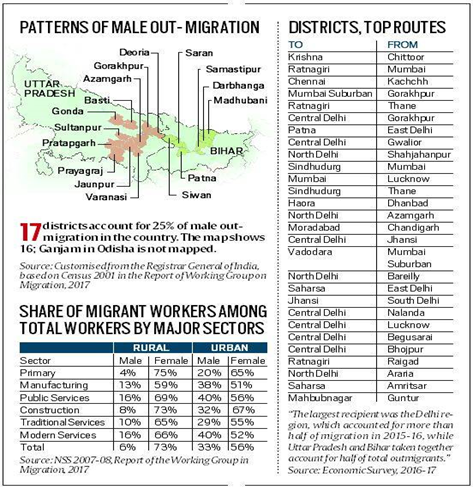

7th March 2023 (6 Topics)
Context
Amid the concerns in Tamil Nadu against the reverse migration of workers/labours of North India, after the fake video got viral showing exploitation of ‘Hindi speaking’ workers in the State.
- There are high chances that economy of the state might get affected.
Who are migrant workers?
- A person who migrates or who has migrated from one country to another with a view to being employed other than on his own account.
- Migrant workers are also known to be much more likely to end up in what are often known as the ‘3D' (dirty, dangerous and demeaning) jobs, such as construction, mining or manual scavenging.
The Statistics for Migration in India:
- The 2011 census reported the number of internal migrants in India at 45.36 crore, making up 37% of the country’s population.
- This number included both inter-state migrants and migrants within each state.
- The annual net migrant flows amounted to about 1 per cent of the working age population.
- As per the 2011 census, India’s workforce was 48.2 crore strong. This figure is estimated to have exceeded 50 crore in 2016 — the Economic Survey that year pegged the size of the migrant workforce at roughly 20 per cent of the population, or more than 10 crore individuals.
- District-wise migration data in the Economic Survey for 2016-17 showed that the highest influx of migrants within the country was in city-districts such as Gurugram, Delhi, and Mumbai; along with Gautam Budh Nagar (Uttar Pradesh); Indore and Bhopal (Madhya Pradesh); Bengaluru (Karnataka); and Thiruvallur, Chennai, Kancheepuram, Erode, and Coimbatore (Tamil Nadu).
|
State-wise data: The highest outward movement of migrant workers was from;
|
- The largest recipient of migrant workers was the Delhi region, which accounted for more than half of migration in 2015-16.
- While Uttar Pradesh and Bihar taken together account for half of total out-migrants.
Issues of Migrant workers:
- Poor implementation of protections under the Inter-State Migrant Workmen Act, 1979 (ISMW Act)
- The ISMW Act provides certain protections for inter-state migrant workers.
- Labour contractors recruiting migrants are required to:
-
-
- Be licensed,
- Register migrant workers with the government authorities, and
- Arrange for the worker to be issued a passbook recording their identity. Guidelines regarding wages and protections (including accommodation, free medical facilities, protective clothing) to be provided by the contractor are also outlined in the law.
-
- Lack of portability of benefits:
- Migrants registered to claim access to benefits at one location lose access upon migration to a different location.
- This is especially true of access to entitlements under the PDS. Ration card required to access benefits under the PDS is issued by state governments and is not portable across states.
- Lack of affordable housing and basic amenities in urban areas
- The proportion of migrants in urban population is 47%.
- In 2015, the Ministry of Housing and Urban Affairs identified migrants in urban areas as the largest population needing housing in cities.
- There is inadequate supply of low-income ownership and rental housing options. This leads to the spread of informal settlements and slums.
- Political Exclusion
- In a state of continuous drift, migrant workers are deprived of many opportunities to exercise their political rights. Because migrants are not entitled to vote outside of their place of origin, some are simply unable to cast their votes.
- Health and Living Conditions
- The migrant labourers working in unorganized sectors work and live in unhygienic and polluted environment are vulnerable to health problems and sickness
- Child Labour
- Children who migrate along with their families are deprived of the free and subsidised, educational facilities offered by the state resulting in Child Labour.

- Children who migrate along with their families are deprived of the free and subsidised, educational facilities offered by the state resulting in Child Labour.
What are the steps taken by the government?
- The Prime Minister Awaas Yojana (PMAY) is a central government scheme to help the economically weaker section and low-income group access housing.
- Pradhan Mantri Garib Kalyan Yojana with a financial package of Rs. 1.7 lakh crore was launched to help poor, needy and unorganised sector workers of the country. Under this package, 80.00 crore people have been provided 5 Kg. Wheat/Rice and 1 Kg. pulses.
- Government of India has launched PM SVANidhi Scheme to facilitate collateral free working capital loan upto Rs.10,000/- of one-year tenure, to approximately, 50 lakh street vendors, to resume their businesses
- One Nation One Ration Card System is an important citizen centric reform. Its implementation ensures availability of ration to beneficiaries under National Food Security Act (NFSA) and other welfare schemes, especially the migrant workers and their families, at any Fair Price Shop (FPS) across the country.

